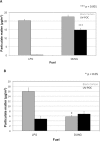A clean fuel cookstove is associated with improved lung function: Effect modification by age and secondhand tobacco smoke exposure
- PMID: 30792415
- PMCID: PMC6385496
- DOI: 10.1038/s41598-018-37887-8
A clean fuel cookstove is associated with improved lung function: Effect modification by age and secondhand tobacco smoke exposure
Abstract
Household air pollution (HAP) secondary to the burning of solid fuels is a major risk factor for the development of COPD. Our study seeks to examine the impact of a clean cookstove, liquid petroleum gas (LPG), on respiratory outcomes. Women (n = 200) from neighboring Indian communities, one cooking with LPG and one with biomass, were enrolled. Spirometry was performed. Relationships between primary cooking fuel and spirometry measures, as raw values, Global Lung Initiative (GLI) percent predicted (pp), and GLI z-scores, were examined using linear regression. Effect modification by age was explored. Women were young (average age 33.3 years), with low education (median 5.0 years), and the majority had multiple sources of air pollution exposures. Overall, the lung function in both groups was poor [FEV1 z-score median -2.05, IQR (-2.64, -1.41). Biomass was associated with lower FEV1/FVC (raw values -7.0, p = 0.04; GLI pp -7.62, p = 0.05, and z-score -0.86, p = 0.05) and FEF25-75 (GLI pp -25.78, p = 0.05, z-score -1.24, p = 0.05), after adjusting for confounders. Increasing impairment in lung function with age was found among biomass users (p-interaction = 0.01). In conclusion, use of a clean fuel cookstove may improve lung function. These findings have broad implications for research and public policy.
Conflict of interest statement
The authors declare no competing interests.
Figures



Similar articles
-
Prevalence and determinants of airflow limitation in urban and rural children exposed to cooking fuels in South-East Nigeria.Paediatr Int Child Health. 2018 May;38(2):121-127. doi: 10.1080/20469047.2018.1445506. Epub 2018 Mar 15. Paediatr Int Child Health. 2018. PMID: 29542392
-
Investigation of Acute Pulmonary Deficits Associated with Biomass Fuel Cookstove Emissions in Rural Bangladesh.Int J Environ Res Public Health. 2017 Jun 15;14(6):641. doi: 10.3390/ijerph14060641. Int J Environ Res Public Health. 2017. PMID: 28617349 Free PMC article.
-
Respiratory symptoms, lung function decrement and chronic obstructive pulmonary disease in pre-menopausal Indian women exposed to biomass smoke.Inhal Toxicol. 2014 Dec;26(14):866-72. doi: 10.3109/08958378.2014.965560. Inhal Toxicol. 2014. PMID: 25472477
-
Household air pollution from domestic combustion of solid fuels and health.J Allergy Clin Immunol. 2019 Jun;143(6):1979-1987. doi: 10.1016/j.jaci.2019.04.016. J Allergy Clin Immunol. 2019. PMID: 31176380 Review.
-
Contributions of biomass/solid fuel burning to blood pressure modification in women: A systematic review and meta-analysis.Am J Hum Biol. 2022 Jan;34(1):e23586. doi: 10.1002/ajhb.23586. Epub 2021 Mar 1. Am J Hum Biol. 2022. PMID: 33645874
Cited by
-
Air Pollutant Exposure and Stove Use Assessment Methods for the Household Air Pollution Intervention Network (HAPIN) Trial.Environ Health Perspect. 2020 Apr;128(4):47009. doi: 10.1289/EHP6422. Epub 2020 Apr 29. Environ Health Perspect. 2020. PMID: 32347764 Free PMC article.
-
Impacts of night market on indoor air quality and lung function of children in nearby households.J Expo Sci Environ Epidemiol. 2025 Mar 20. doi: 10.1038/s41370-025-00755-5. Online ahead of print. J Expo Sci Environ Epidemiol. 2025. PMID: 40113881
-
Positive impact of improved cookstove usage on respiratory health in Congolese refugees: a prospective cohort study.Environ Sci Pollut Res Int. 2020 Feb;27(4):4509-4512. doi: 10.1007/s11356-019-06816-1. Epub 2019 Nov 25. Environ Sci Pollut Res Int. 2020. PMID: 31768954
-
Improved cookstoves enhance household air quality and respiratory health in rural Rwanda.Sci Rep. 2025 Jul 18;15(1):26065. doi: 10.1038/s41598-025-09863-6. Sci Rep. 2025. PMID: 40681630 Free PMC article. Clinical Trial.
-
Exposure contrasts associated with a liquefied petroleum gas (LPG) intervention at potential field sites for the multi-country household air pollution intervention network (HAPIN) trial in India: results from pilot phase activities in rural Tamil Nadu.BMC Public Health. 2020 Nov 26;20(1):1799. doi: 10.1186/s12889-020-09865-1. BMC Public Health. 2020. PMID: 33243198 Free PMC article. Clinical Trial.
References
-
- Lim SS, et al. A comparative risk assessment of burden of disease and injury attributable to 67 risk factors and risk factor clusters in 21 regions, 1990-2010: a systematic analysis for the Global Burden of Disease Study 2010. Lancet (London, England) 2012;380:2224–2260. doi: 10.1016/s0140-6736(12)61766-8. - DOI - PMC - PubMed
Publication types
MeSH terms
Substances
Grants and funding
LinkOut - more resources
Full Text Sources
Medical
Miscellaneous

